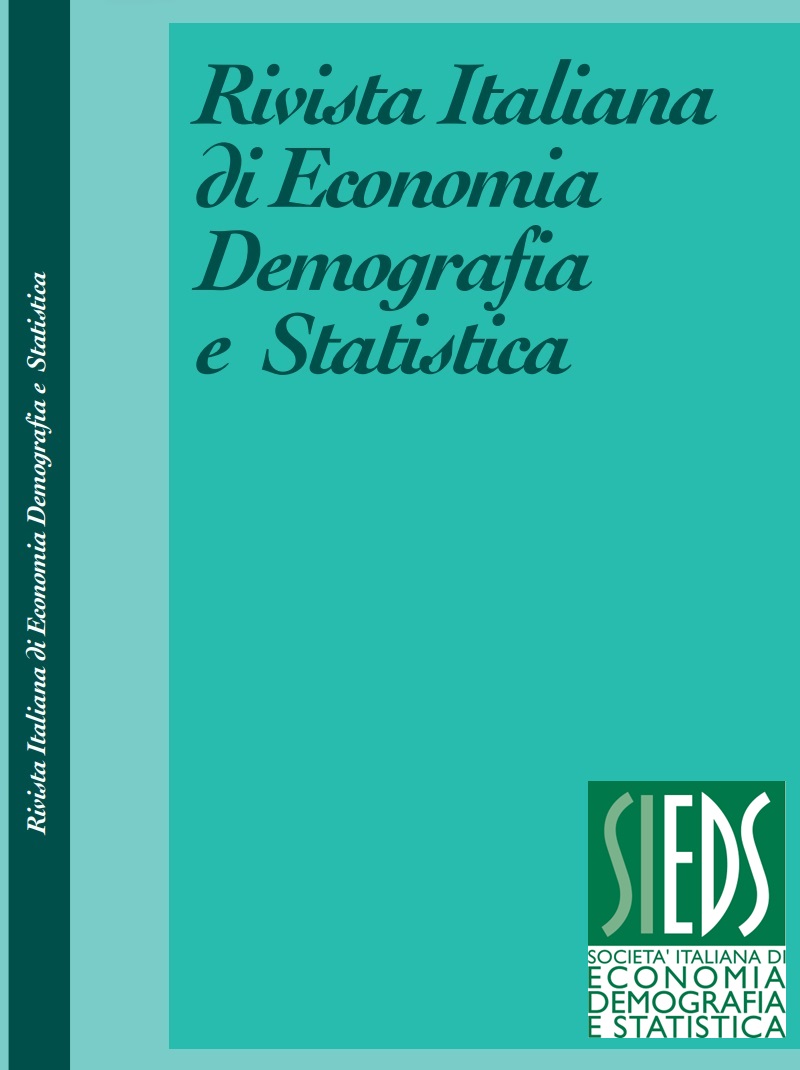The geography of green innovation
DOI:
https://doi.org/10.71014/sieds.v79i4.385Abstract
In the last decades, the geography of innovation activity became much more concentrated. By focusing on the metropolitan statistical area of residence of the inventors of patents granted by the United States Patents and Trademark Office between 1976 and 2020, we investigate whether this is true also for "green" innovation, i.e. patents covering mitigation or adaptation to climate change. We find a sharp increase in concentration across areas after the beginning of the 2000s, with areas that are generally more innovative also producing more green patents. Moreover, for an in-depth analysis of spatial dependence patterns, we firstly survey the literature to find tests suitable for comparing spatial patterns and then apply these tests to the data on green patenting in comparison with non-green patenting. We find significant differences between the two phenomena.
References
AGHION P., AKCIGIT U., BERGEAUD A., BLUNDELL R., HEMOUS D. 2019. Innovation and top income inequality. Review of Economic Studies, Vol. 86, No. 1, pp. 1–45. DOI: https://doi.org/10.1093/restud/rdy027
ALBA-FERNANDEZ M.V., ARIZA-LOPEZ F.J., JIMENEZ-GAMERO M.D., RODRIGUEZ-AVI J. 2016. On the similarity analysis of spatial patterns. Spatial Statistics, Vol. 18, pp. 352-362, DOI: https://doi.org/10.1016/j.spasta.2016.07.004
ANDRESEN M.A. 2009. Testing for similarity in area-based spatial patterns: a non parametric Monte Carlo approach. Applied Geography, Vol. 29, No. 3, pp. 333–345. DOI: https://doi.org/10.1016/j.apgeog.2008.12.004
ANDREWS M.J., WHALLEY A. 2021. 150 years of the geography of innovation. Regional Science and Urban Economics, Vol. 94, pp. 103-127 DOI: https://doi.org/10.1016/j.regsciurbeco.2020.103627
ANSELIN L. 1995. Local Indicators of Spatial Association LISA. Geographical Analysis, Vol. 27, pp. 93-115. DOI: https://doi.org/10.1111/j.1538-4632.1995.tb00338.x
AUDRETSCH D.B., FELDMAN M.P. 1996. R&D spillovers and the geography of innovation and production. The American Economic Review, Vol. 86, No. 3, pp. 630–640.
BERKES E., GAETANI R. 2021. The Geography of Unconventional Innovation. The Economic Journal, Vol. 131, pp. 1466–1514. DOI: https://doi.org/10.1093/ej/ueaa111
BUZARD K., CARLINO G.A., HUNT R.M., CARR J.K., SMITH T.E, 2017. The agglomeration of American R&D labs. Journal of Urban Economics, Vol. 101, pp. 14–26. DOI: https://doi.org/10.1016/j.jue.2017.05.007
CASTALDI C, LOS B, 2017. Geographical patterns in US inventive activity 1977–1998: The “regional inversion” was underestimated. Research Policy, Vol. 46, No. 7, pp. 1187–1197. DOI: https://doi.org/10.1016/j.respol.2017.04.005
CLIFFORD P., RICHARDSON S., HEMON D. 1989. Assessing the significance of the correlation between two spatial processes. Biometrics, Vol. 45, pp. 123-134. DOI: https://doi.org/10.2307/2532039
CORROCHER N., MALERBA F., MORRISON A. 2021. Technological regimes, patent growth, and catching-up in green technologies. Industrial and Corporate Change, Vol. 30, No. 4, pp. 1084–1107. DOI: https://doi.org/10.1093/icc/dtab025
DELGADO M., PORTER ME., STERN S. 2014. Clusters, convergence, and economic performance. Research Policy, Vol. 43, pp. 1785-1799 DOI: https://doi.org/10.1016/j.respol.2014.05.007
DRENNAN MP. 2005. Possible sources of wage divergence among metropolitan areas of the United States. Urban Studies, Vol. 42, No. 9, pp. 1609–1620. DOI: https://doi.org/10.1080/00420980500185538
DUTILLEUL P., CLIFFORD P., RICHARDSON S., HEMON D. 1993. Test for assessing the correlation between two spatial processes. Biometrics, Vol. 49, No. 1, pp. 305-314. DOI: https://doi.org/10.2307/2532625
ELLISON G., GLAESER E. 1997. Geographic concentration in U.S. manufacturing industries: A dartboard approach. Journal of Political Economy, Vol. 105, No. 5, pp. 889–927. DOI: https://doi.org/10.1086/262098
FLORIDA R. 2009. Who’s your city? New York: Basic Books.
FORMAN C., GOLDFARB A. 2021. Concentration and agglomeration of IT innovation and entrepreneurship: Evidence from patenting. DOI: https://doi.org/10.3386/w27338
GLAESER EL., GOTTLIEB J.D. 2009. The Wealth of Cities: Agglomeration Economies and Spatial Equilibrium in the United States. Journal of Economic Literature, Vol. 47, No. 4, pp. 983–1028. DOI: https://doi.org/10.1257/jel.47.4.983
GREENSTONE M., HORNBECK R., MORETTI E. 2010. Identifying Agglomeration Spillovers: Evidence from Winners and Losers of Large Plant Openings. Journal of Political Economy. Vol. 118, No. 3 pp. 536-598. DOI: https://doi.org/10.1086/653714
JAFFE A., TRAJTENBERG M., HENDERSON R, 1993. Geographic Localization of Knowledge Spillovers as Evidenced by Patent Citations. The Quarterly Journal of Economics. Vol. 108, No. 3, pp. 577-598 DOI: https://doi.org/10.2307/2118401
KERR W., KOMINERS S. 2015. Agglomerative Forces and Cluster Shapes. The Review of Economics and Statistics, 2015, vol. 97, No. 4, 877-899.. DOI: https://doi.org/10.1162/REST_a_00471
LERNER J., SERU A. 2022. The Use and Misuse of Patent Data: Issues for Finance and Beyond. The Review of Financial Studies, Vol. 35, No. 6, pp. 2667–2704. DOI: https://doi.org/10.1093/rfs/hhab084
MAGRINI S., SPIGANTI A. 2024. A tale of two cities: Communication, innovation, and divergence. Economic Inquiry, Vol. 62, No. 1, pp. 390–413. DOI: https://doi.org/10.1111/ecin.13175
MARSHALL A. 1890. Principles of economics. London: Macmillan.
MORETTI E. 2021. The Effect of High-Tech Clusters on the Productivity of Top Inventors. American Economic Review, Vol. 11, No. 10, pp. 3328–3375. DOI: https://doi.org/10.1257/aer.20191277
VALLEJOS R., OSORIO F., BEVILACQUA M. 2020. Spatial Relationships Between Two Georeferenced Variables: With Applications in R. Cham: Springer. DOI: https://doi.org/10.1007/978-3-030-56681-4
VEEFKIND V., HURTADO-ALBIR J., ANGELUCCI S., KARACHALIOS K., THUMM N. 2012. A new EPO classification scheme for climate change mitigation technologies. World Patent Information, Vol. 34, No. 2, pp. 106–111. DOI: https://doi.org/10.1016/j.wpi.2011.12.004
Downloads
Published
Issue
Section
License
Copyright (c) 2025 Margherita Gerolimetto, Stefano Magrini, Alessandro Spiganti

This work is licensed under a Creative Commons Attribution 4.0 International License.



